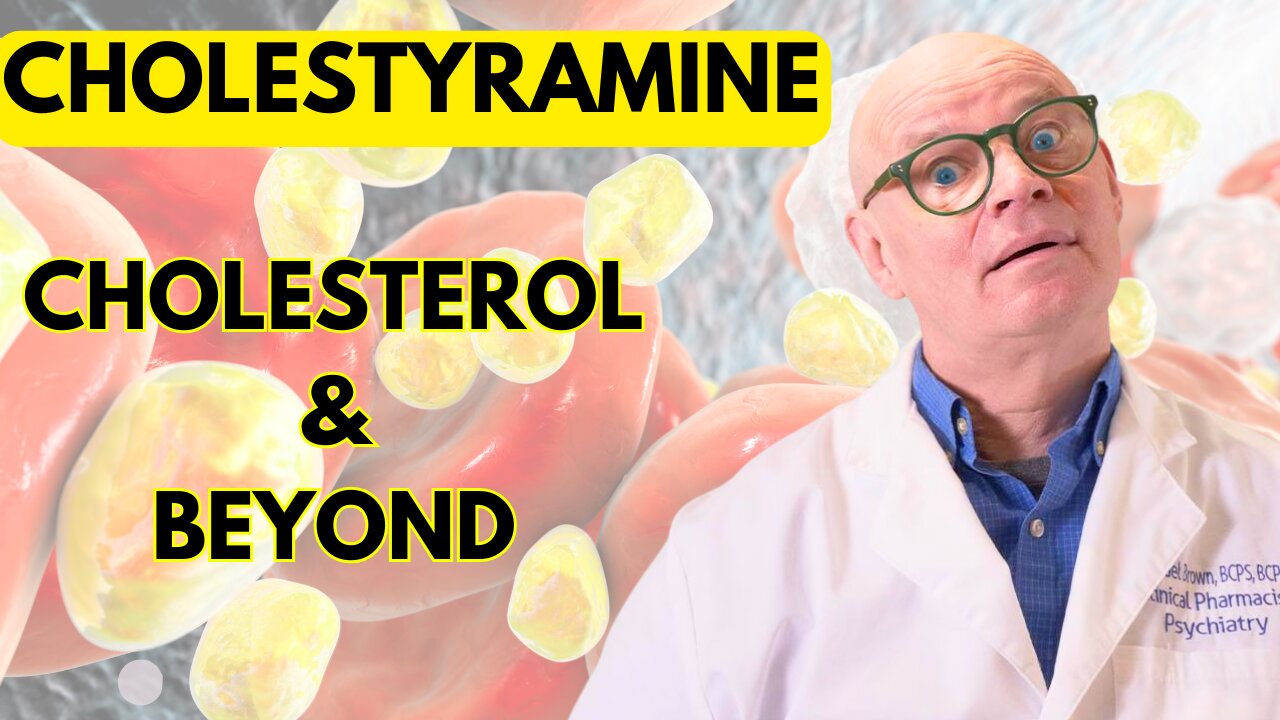Premium Only Content

Cholestyramine Explained: Managing Cholesterol & Liver Health
Cholestyramine is a bile acid sequestrant used primarily for lowering cholesterol levels and treating specific conditions related to bile acid malabsorption. It operates by binding bile acids in the intestine, preventing their reabsorption. This process not only helps in reducing the cholesterol level in the blood but also aids in the management of itching associated with certain liver diseases. This essay explores the uses, side effects, and considerations regarding who should and should not use cholestyramine.
Uses of Cholestyramine
Cholestyramine's primary use is in the management of hyperlipidemia, specifically, lowering low-density lipoprotein (LDL) cholesterol, often referred to as "bad" cholesterol. By binding with bile acids, cholestyramine forces the liver to use excess cholesterol to produce more bile acids, thereby lowering the cholesterol level in the bloodstream. This mechanism is crucial in preventing the development of atherosclerosis and subsequent cardiovascular diseases.
Additionally, cholestyramine is utilized in treating pruritus (itching) associated with partial biliary obstruction. The binding action of cholestyramine on bile acids in the gastrointestinal tract can reduce the levels of bile acids that accumulate in the skin, which are thought to cause itching.
Another notable use of cholestyramine is in the management of diarrhea resulting from bile acid malabsorption, where it helps by reducing excessive bile acids in the colon.
Side Effects
While cholestyramine is effective in managing cholesterol levels and related conditions, it is not without its side effects. Common adverse effects include gastrointestinal disturbances such as constipation, abdominal pain, and bloating. Given its mechanism of action, cholestyramine can also interfere with the absorption of other drugs and fat-soluble vitamins (A, D, E, and K), potentially leading to deficiencies if not monitored and managed appropriately.
Less commonly, individuals may experience nausea, increased liver enzymes, or hypersensitivity reactions, including rash and hives. Due to its impact on the digestive system, long-term use of cholestyramine requires monitoring and, occasionally, supplementation of fat-soluble vitamins to prevent deficiencies.
Who Should and Should Not Use Cholestyramine
Cholestyramine is suitable for individuals with high LDL cholesterol levels who have not sufficiently responded to diet and lifestyle modifications. It can also benefit patients experiencing itching due to partial biliary obstruction and those with diarrhea from bile acid malabsorption.
However, cholestyramine is contraindicated in individuals with complete biliary obstruction, where bile flow from the liver to the intestines is blocked, as its mechanism of action depends on binding bile acids in the intestines. Furthermore, patients with a known hypersensitivity to cholestyramine or any of its components should avoid using this medication.
Due to its potential to interfere with the absorption of other medications, patients taking cholestyramine should carefully manage the timing of their medications, typically taking other drugs at least 1 to 2 hours before or 4 to 6 hours after cholestyramine to minimize interactions.
Conclusion
Cholestyramine remains a valuable tool in managing high cholesterol levels and conditions related to bile acid malabsorption. Its ability to lower LDL cholesterol and treat symptoms like itching associated with liver diseases highlights its importance in therapeutic strategies. However, its side effects and potential interactions with other medications necessitate careful consideration and monitoring by healthcare professionals. Patients and healthcare providers must work closely together to ensure that cholestyramine is used safely and effectively, tailoring treatment to the individual's specific health needs and conditions.
-
 3:16:38
3:16:38
Price of Reason
11 hours agoTrump FIRES Fed Governor Lisa Cook! Cracker Barrel CRISIS Continues! James Gunn DCU Woes! Gamescon!
106K7 -
 2:25:01
2:25:01
FreshandFit
6 hours agoTyreek Hill Pays Ex Wife $1 Million in Ongoing Fees From Divorce?!
30.5K3 -
 2:03:46
2:03:46
Inverted World Live
8 hours agoHaunted Dolls Hack Amazon Alexa | Ep. 98
104K2 -
 3:09:53
3:09:53
Laura Loomer
8 hours agoEP140: Loomer EXPOSES Islamification At US State Department
33.6K12 -
 3:05:00
3:05:00
TimcastIRL
8 hours agoTrump Floats Accepting 600,000 Chinese Student Visas, MAGA Uproar | Timcast IRL
209K150 -
 8:44:47
8:44:47
SpartakusLIVE
13 hours ago$20,000 Hide and Seek Tourney w/ Stonemountain64 || #1 Rat wins the BIG CHEESE
69.9K -
 2:34:02
2:34:02
Barry Cunningham
9 hours agoLISA COOK | ADAM SCHIFF | LETITIA JAMES | ARE THEY BEING SACRIFICED BY THE DEEP STATE?
102K61 -
 1:36:19
1:36:19
Flyover Conservatives
17 hours agoOnly 17% of Millennials Hit These 5 Adult Milestones—Why?; What If Childhood Trauma Is Behind Your Health Problems? - Dr. Troy Spurrill | FOC Show
40.4K4 -
 4:49:04
4:49:04
HogansAlleyHero
19 hours ago💥CHASING DOPAMINE💥✅TRUMP SAYS BATTLEFIELD IS THE BEST✅
51.8K3 -
 1:57:40
1:57:40
MattMorseTV
9 hours ago $13.69 earned🔴Trump just SHATTERED the PROJECTIONS.🔴
61.1K53